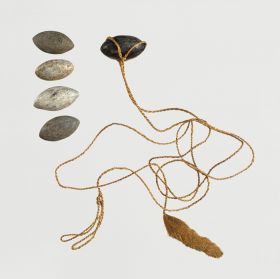Sling and sling stones
Place: New Caledonia
Category: War
Sling, plant fibre, New Caledonia, l. 220 cm, Inv. Oz 693; Sling stones, New Caledonia, l. 4.9–6 cm, Inv. Oz 694–698
Sling, Inv. Oz 693
Humphrey No. 340: ‘a Sling made of cordage with a tufted end, from New Caledonia.’
The sling consists of a cord made of two twisted plant fibre strings about 2 mm thick. At the pouch for the sling stone, over a length of 10.5 cm, three skeins of fibres are braided into a plait. One end is formed by two loops with a length of 9.5 cm, into which one or two fingers can be inserted. The other end consists of a tuft about 8 cm long and made of the same fibre material as the rest of the sling.
There is no old label present, though there are references to a sling of this type in both registers. The text cited above is taken from the Humphrey catalogue. The Register of the Forster South Sea Items contains the entry ‘18) a sling from Mallicolò’ in the section ‘A. Weapons.’ This, however, is a sling from the Society Islands (Oz 702) with a faded Forster label adhering to its back. Sarasin (1929), for New Caledonia, and Speiser (1923), for the New Hebrides, agreed that slings such as Oz 693 were only found on New Caledonia. Comparable slings from Cook’s voyage are probably still to be found in Oxford and possibly also in Florence (Kaeppler 1978a: 244). Volker Harms
Four sling stones, Inv. Oz 694, Inv. Oz 696, Inv. Oz 697, Inv. Oz 698, Forster Register A. 19: ‘a bag full of stones [from Mallicolò]’.
The sling stones have the shape of a symmetrical egg pointed at both ends, made by being artificially ground. The stone itself is of ‘steatite’. The Göttingen Collection has five stones of this kind, all with the same shape and the same origin, ‘New Caledonia’. There is still a Humphrey label on only one of them (see Oz 695). It is most probable that the pieces listed here can be attributed to the Forster Collection for the following reasons. The entry in the Register of this collection (‘a bag full of stones’) gives no information regarding the number of these stones, but only that they were found in this bag and, since the bag itself had a label with the typical ‘F.’, the stones did not receive their own, additional, individual labels. A number of substantial arguments counter the regional origin ‘from Mallicolò’ in the Register. These will be discussed in the description of the hip bag (see Oz 705) to which this information refers. However, the regional origin ‘New Caledonia’ and the connection to Cook’s second voyage may be assumed to be relatively certain.
Comparable sling stones which also came from a collection assembled by J.R. Forster may also be found in Oxford (Kaeppler 1978a: 244). Volker Harms
Sources
Kaeppler, Adrienne L, ‘Artificial Curiosities’ Being An Exposition of Native Manufactures Collected on the Three Pacific Voyages of Captain James Cook RN [Exhibition catalogue], Bishop Museum Press, Honolulu, 1978a.
Sarasin, Fritz, Ethnologie der Neu-Caledonier und Loyalty-Insulaner, Munich, 1929.
Speiser, Felix, Ethnographische Materialien aus den Neuen Hebriden und den Banks-Inseln, Berlin, 1923.
Related artefacts
Sling ma'a, Inv. Oz 702
Hip bag (for sling stones), Inv. Oz 705

